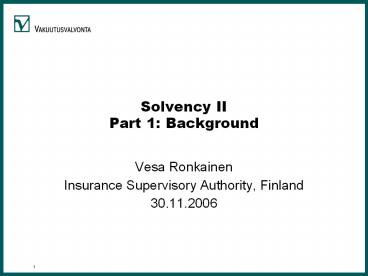Solvency II Part 1: Background - PowerPoint PPT Presentation
Title:
Solvency II Part 1: Background
Description:
1. Solvency II. Part 1: Background. Vesa Ronkainen. Insurance Supervisory Authority, Finland ... Current Solvency I Directives (Non-life: 2002/12/EC, Life: 2002 ... – PowerPoint PPT presentation
Number of Views:38
Avg rating:3.0/5.0
Title: Solvency II Part 1: Background
1
Solvency IIPart 1 Background
- Vesa Ronkainen
- Insurance Supervisory Authority, Finland
- 30.11.2006
2
Structure of presentation
- Part 1 Background for Solvency II
- Part 2 Pillar 1 (quantitative requirements)
- Part 3 Other pillars
- Part 4 Quantitative Impact Studies
3
Contents of Part 1
- 1. Solvency I
- 2. Solvency II process
- 3. Three pillar structure of Solvency II
4
1. Solvency I
- Current Solvency I Directives (Non-life
2002/12/EC, Life 2002/83/EC) are based on the
1st, 2nd and 3rd life and non-life insurance
directives of the 1970s, with some improvements - Capital requirements (solvency margin) are of the
form factorvolume measure (e.g. premiums,
claims, technical provisions, sum at risk)
5
Solvency I Directive 2002/83/EC
- Title III Conditions governing the business
- Ch. 1 Principles and methods of financial
supervision - Ch. 2 Rules relating to technical provisions
(23 Categories of authorised assets) - Ch. 3 Rules relating to solvency margin and
guarantee fund (27 Available solvency margin,
28 Required solv.margin, 29 Guarantee fund) - Ch. 4 Contract law and conditions of insurance
- Ch. 5 Undertakings in difficulty
6
Solvency I Directive (cont)
- Title I Definitions and scope
- Title II The taking up of the business
- Title III (see above)
- Title IV Provisions relating to right of
establishment and freedom to provide services - Title V Rules applicable to agencies or branches
of third countries - Title VI Rules applicable to subsidiaries of
parent undertakings from third countries - Titles VII-VIII Transitional and final
provisions
7
2. Solvency II process
- 2.1 What is Solvency II?
- 2.2 Why Solvency II?
- 2.3 Who is involved?
- 2.4 Timing? Where are we?
- 2.5. The 3 pillar structure of Solvency II
8
2.1 What is Solvency II?
- More harmonised and risk-based solvency regime
for life, non-life and reinsurance companies in
the EU - Comprehensive and advanced supervisory system
including both quantitative and qualitative
requirements - Risk management is in focus
- International compatibility (Basel II, IFRS,
IAIS, IAA) - Good news for policy-holders
- Good for the EUs internal market (and
internationally)
9
2.2 Why Solvency II?
- The current EU regime Solvency I causes
regulatory capital to diverge from an economic
capital driven requirement for many reasons - An undefined level of prudence is required in
technical provision - The benefits of pooling and diversifying risk are
only recognized to a limited extent and the
capital requirement only partially reflects
reinsurance and other forms of risk mitigation - For life insurance business the interaction of
technical provision and the solvency margin can
create irrational effects where greater prudence
in the solvency provision leads to an increased
solvency margin
10
2.2 Why Solvency II (cont.)
- Asset risks are not adequately recognized in the
capital requirements instead quantitative
restrictions are imposed which can distort
portfolio choices and - A proper asset/liability management is not
adequately rewarded. - Given a companys risk profile, tend to impose
capital requirements that for many firms are too
low to ensure adequate solvency - Does not provide supervisors with harmonised
tools to foster high quality risk management and
control which is as important for policyholder
protection as the level of solvency itself. - In Solvency II we will supervise the overall
financial - soundness and solvency of an insurance firm,
including all - the assets and liabilities (the total balance
sheet)
11
2.3 Solvency II builds on Lamfalussy approach
Level 1 Framework Directive
Level 2 Implementing Measures (EIOPC)
Level 3 Guidelines (CEIOPS)
Level 4 Enforcement of community Law
12
2.3 Who is involved?
13
2.4 Timing?
Directive development (Commission)
Directive adopted? (Council and Parlament)
Implementation? (Member States)
CEIOPS gives advice to the Commission
CEIOPS gives advice for Level
II Implemeting measures
CEIOPS gives Level III Supervisory Guidance
Testing the impacts via QISs
14
2.5 Solvency II 3 pillars
Pillar 1
Pillar 2
Pillar 3
- Quantitative Capital Requirements
- Technical Provisions
- Minimum Capital
- Risk Based Capital
- Eligible Elements of Capital
- Admissible Assets
Supervision Internal Controls Risk Management
Framework Transparency of Supervision Supervisor
y Review Processes Powers
Disclosure Transparency Disclosure to
reinforce market discipline
15
CALLS FOR ADVICE(from the EC to CEIOPS)
1. INTERNAL CONTROL AND RISK MANAGEMENT 2.
SUPERVISORY REVIEW PROCESS (GENERAL) 3.
SUPERVISORY REVIEW PROCESS (QUANTITATIVE
TOOLS) 4. TRANSPARENCY OF SUPERVISORY ACTION 5.
INVESTMENT MANAGEMENT RULES 6. ASSET-LIABILITY
MANAGEMENT 7. TECHNICAL PROVISIONS IN LIFE
ASSURANCE 8. TECHNICAL PROVISIONS IN NON-LIFE
INSURANCE 9. SAFETY MEASURES 10. SOLVENCY CAPITAL
REQUIREMENT STANDARD FORMULA (LIFE AND
NON-LIFE) 11. SOLVENCY CAPITAL REQUIREMENT
INTERNAL MODELS (LIFE AND NON-LIFE) AND THEIR
VALIDATION 12. REINSURANCE (AND OTHER RISK
MITIGATION TECHNIQUES) 13. QUANTITATIVE IMPACT
STUDY AND DATA RELATED ISSUES 14. POWERS OF THE
SUPERVISORY AUTHORITIES 15. SOLVENCY CONTROL
LEVELS 16. FIT AND PROPER CRITERIA 17. PEER
REVIEWS 18. GROUP AND CROSS-SECTORAL ISSUES 19.
ELIGIBLE ELEMENTS TO COVER THE CAPITAL
REQUIREMENTS 20. COOPERATION BETWEEN SUPERVISORY
AUTHORITIES 21. SUPERVISORY REPORTING AND PUBLIC
DISCLOSURE 22. PROCYCLICALITY 23. SMALL
UNDERTAKINGS
1st Wave
2nd Wave
3rd Wave































